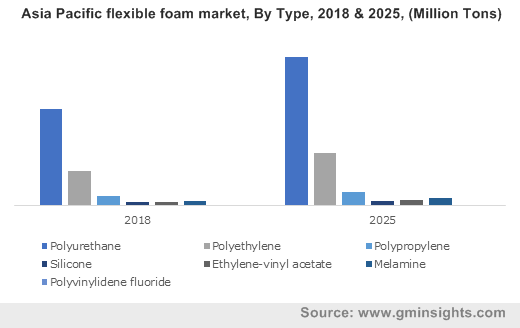APAC flexible foam market to accumulate commendable gains by 2025, escalating product demand from the automotive & construction sectors to proliferate the industry landscape
Publisher : Fractovia | Published Date : 2019-02-21Request Sample
Endorsed by a powerful end-use spectrum spanning the consumer goods, packaging, and construction sectors, the global flexible foam market growth graph has depicted a major incline in recent years. Being one of the most versatile materials used in end-user products, this foam has seemingly found applications in bedding, pillows, mattresses, carpet cushion, automotive interiors and more. Undeniably, the product’s cushioning property makes it ideal for applications like packaging to protect delicate goods, while the same property applies to upholstered furniture where the foam provides added comfort. Equipped with features such as high resiliency, light weight, durability, and improved safety & comfort, the material is bound to be deployed in numerous other verticals, paving the way for flexible foam industry share to increase exponentially.
Asia Pacific flexible foam market, By Type, 2018 & 2025, (Million Tons)

Flexible polyurethane foam is one of the many foam types that is reputed to majorly enhance an end-user product’s comfort level and resiliency. The material is mainly used in carpet cushions and furniture, though lately, automotive interiors have also cropped up as a primary application avenue. Furthermore, the product is proven to be ideal for use in thermal insulation products used in modern buildings.
The reason PU foam has gained such a massive traction can be attributed to its features such as enhanced cushioning, lightweight, durability, increased shelf life, lower installation time and high resiliency. As per reports, over 2.1 billion pounds of FPF are produced and used in the U.S. every year. Pertaining to its widespread application terrain, polyurethane led the overall flexible foam market in 2018 with a share of 60%.
The furniture industry will irrefutably be a major contributor toward the flexible foam industry, given the growing product adoption for manufacturing goods that offer enhanced comfort and durability. FPF for instance, is essentially responsible for endorsing the comfort system of upholstered furniture. The versatility of flexible foam gives furniture designers more freedom to implement newer ideas and develop designs that attract customers. The right foam specification allows designers to develop a thinner profile cushion which also offers improved seating comfort. As customers seek diverse furniture options to accommodate in smaller homes without compromising on comfort and establishments such as restaurants spend extensively on luxurious seating arrangements to impress their patrons, flexible foam industry will accrue commendable profits from the furniture segment. As a matter of fact, global flexible foam market size from furniture & upholstery stood at an appreciable USD 10 billion in 2018.
The automotive industry is another lucrative end-use sector of the flexible foam market. Given that the product offers stress and tensile handling properties, and increased resistance to solvents and light, it is used extensively in the transportation industry for making seats, armrests, headrests, HVAC components, interior panels and skins, truck beds, headliners, and other interior systems. Polyurethane foam is also used to offer automobile designers and manufacturers the means to make products that can easily be assembled, disassembled, and recycled. The product also meets the highest performance specifications over a wide range of automotive applications without increasing vehicle weight. Despite heavy, prolonged use over the years, polyurethane foam can retain its original shape, firmness, and resiliency. Recent developments in polyurethane technology for automotive design will contribute towards improving passenger comfort, energy and sound absorption, moisture and heat resistance and compressive strength in vehicles. In consequence, flexible foam market is likely to procure a major chunk of its profits from the automotive sector.
The Asia Pacific flexible foam market will register extensive growth in the ensuing years owing to the rising consumer spending on luxurious products coupled with the surging demand for memory foams used in mattresses and beddings. The significant expansion of the regional construction industry due to increase in disposable incomes and the proliferating automotive sector across the economies of China, India, and Japan, that has been transitioning to using lightweight, durable, and aesthetic vehicle equipment to gain a competitive lead against rivals, will further stimulate the APAC flexible foam market trends. Estimates in fact, claim that the APAC emerged as the dominant regional flexible foam market in 2018, with a share of 30% of the overall demand.
Powered by rapid innovations in the construction and automotive sector and the ongoing furniture trends pertaining to durable, lightweight seating, flexible foam market is expected to make robust inroads in the years ahead. Developing economies such as India and China will significantly impact the product development owing to a huge potential customer base along with inclination of consumers towards luxurious interiors and vehicles. According to Global Market Insights, Inc., the flexible foam market size is anticipated to surpass USD 65 billion by 2025.